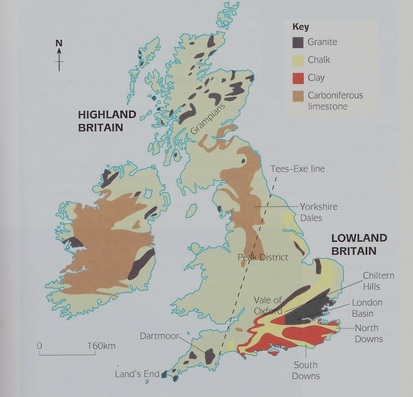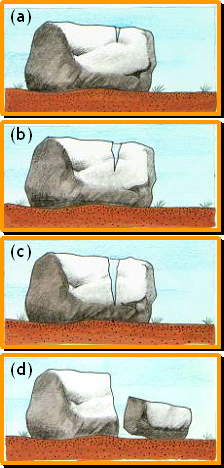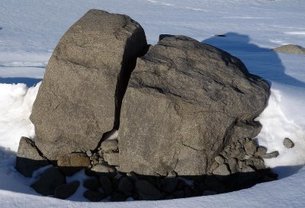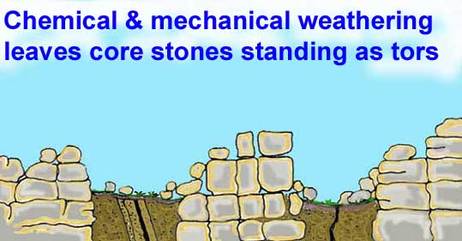GCSE Geography First Hand
Rocks, Resources and Scenery
Types of Rock
There are three types of rock:
1. Sedimentary
-Clays and Shales are made from mud and clay minerals. the particles have been eroded from older rocks, deposited in layers over time on the sea or lake beds then compacted together.
2. Igneous
All Igneous rocks are formed when molten rock from the mantle cools and hardens.
There are two types of Igneous rock, which depends on where the magma cools:
-The magma cools very slowly as it is closer to the heat source. This means the rock has large crystals and a coarse texture.
-The magma cools very quickly as it is further from the heat source. This means the rock has small crystals and a fine texture.
3. Metamorphic
Metamorphic rocks are formed when other rock(ignous, sedimentary and older metamorphic rocks) are changed by heat and pressure:
1. Sedimentary
- Formed when layers of sediment made of small particles of rock, eroded and transported by the wind, rivers and ice; crushed up shell and dead sea creatures and crushed up minerals are compacted together until they become layeers of solid rock. This process is called Lithifaction. Here are a few examples:
-Clays and Shales are made from mud and clay minerals. the particles have been eroded from older rocks, deposited in layers over time on the sea or lake beds then compacted together.
2. Igneous
All Igneous rocks are formed when molten rock from the mantle cools and hardens.
There are two types of Igneous rock, which depends on where the magma cools:
- Intrusive rock e.g. Granite
-The magma cools very slowly as it is closer to the heat source. This means the rock has large crystals and a coarse texture.
- Extrusive rock e.g. Basalt
-The magma cools very quickly as it is further from the heat source. This means the rock has small crystals and a fine texture.
3. Metamorphic
Metamorphic rocks are formed when other rock(ignous, sedimentary and older metamorphic rocks) are changed by heat and pressure:
- Rocks deep in the Earth are changed by the pressure of the material above them.
- When tectonic Plates collide, rocks are changed by the massive heat and pressure that builds up due to immense friction.
- Magma from the mantle heats the rocks in the crust, causing them to change.
The Rock Cycle
The Rock Cycle shows how Sedimentary, Igneous and Metamorphic rocks are formed, destroyed and re-formed.
- Weathering(the breakdown of rock) of all three rock types create loose sediment.
- This makes it easier for erosion(the removal of rock) to occur.
- The Sediment is transported away(e.g. by Rivers) and deposited on the sea bed.
- Sediment is compacted on the sea bed through lithifaction to form Sedimentary Rocks.
- Heat and Pressure (e.g. from overlaying layers of rock) can change any rock type to new Metamorphic Rock.
- Melting of any rock typ (e.g. in the mantle) creates magma. When the magma cools, Igneous Rocks are formed.
- The whole process repeats and keeps on repeating. It is still happening today, but it takes so long to happen that we don't notice.
Geological Time compared to Human Time
The rocks found in the Uk today were all formed many millions of years ago.
Humans have only been around for the last 200,000 years, so the rock cycle is on a totally different time scale to human time.
Humans have only been around for the last 200,000 years, so the rock cycle is on a totally different time scale to human time.
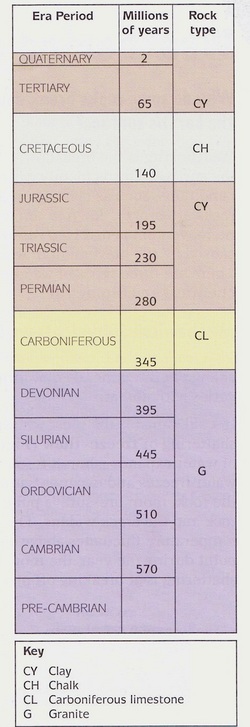
This table shows the most recent Geological Periods,don't worry you don't have to learn them :)
Weathering and Erosion
- Weathering is the breakdown of Rocks in Situ(in their place of origin)
- Erosion is the process of Weathering and Transport of rocks.
There are three types of Weathering, lets start with Mechanical Weathering:
1. Freeze-Thaw Weathering
- In some areas, the temperature is above 0 degrees in the day and below 0 degrees at night.
- During the day, water seeps into cracks in a Rock.
- At night the water Freezes, expanding by about 9%, which puts pressure on the rock.
- The water Thaws the next day, releasing the pressure from the Rock.
- The process repeats every day and night unti the cracks are wide enough to cause the rock to break.
2. Exfoliation Weathering(Onion Skin)
1. Solution Weathering
Thats "Calcium Carbonate+Carbon Dioxide+Water→Calcium Bicarbonate"in words.
Lastly is Biological Weathering:
- In some areas, the temperature has a large range. In the desert the temperatures reach 40 degrees in the day and 5 degrees at night.
- Each day the surface layers of the rock heat up and expand faster than the inner layers.
- At night the surface layers of the rock coold down and contract faster than the inner layers.
- This creates pressure within the rock and causes the surface layers to peel off, much like an Onion Skin.
1. Solution Weathering
- Some minerals that make up rocks are soluble in water(rock salt)
- The minerals dissolve in rainwater, breaking down the rock.
- Carbon Dioxide dissolves in rainwater to make a weak Carbonic Acid.
- Carbonic Acid reacts with Calcium Carbonate in rocks(Carboniferous Limestone), so the rocks are dissolved by the rainwater.
Thats "Calcium Carbonate+Carbon Dioxide+Water→Calcium Bicarbonate"in words.
Lastly is Biological Weathering:
- Plant roots break down rocks by growing into cracks and expanding them by forcing them apart.
- Burrowing animals may loosen small amounts of rock material.
Rocks and Landscpaes
Some facts you'll need to know about different types of Landscapes:
Granite Landscapes
- Granite is impermeable(it doesn't let water through)
- This creats moorland-large areas of waterlogged and acidic soil, with low-growing vegetation.
- Tors:
- Granite is well jointed which aren't evenly spread, they are closer together in some parts.
- Freeze-Thaw and Chemical Weathering wear down parts of the rock with joints close together faster than parts or the rock where joints are spread around, because more water can get into more cracks making the process faster.
- Sections of Granite with fewer joints are weathered more slowly. Because of this, sections of Granite are left sticking out of the ground. These are called Tors.
4. Batholiths:
- Intrusive Igneous rock, ususally Granite, forms very large bodies under the Earth's surface.
- Sometimes, the rock above it is eroded away, leaving a body of Granite exposed on the surface.
- Chalk is an Aquifier-a Permeable rock that stores water.
- Water flows through Chlak and emerges where Chalk meets Impermeable rock(Clay) Where the water emerges is called a Spring Line.
- Areas of CHalk can also have Dry Valleys-Valleys that don't have a river or stream flowing in them because the water is flowing underground.
- Excarpments:
- Horizontal layers of Chalk and CLay are sometimes tilted diagonally by Crustal Uplift (movements caused by Tectonic activity)
- The Clay is less resistant to Weathering than Chalk so is Eroded faster.
- The Chalk is left sticking out forming Escarpments. Where the clay has been eroded, it forms Vales-wide areas of flat land.
- Escarpments have steep slopes(Scarp slopes) at one end and gentle slopes(dip slopes) on the other.
- The Scarp slopes are perpendicular to the Bedding planes whilst the Dip slopes are parallel to the Bedding planes.
